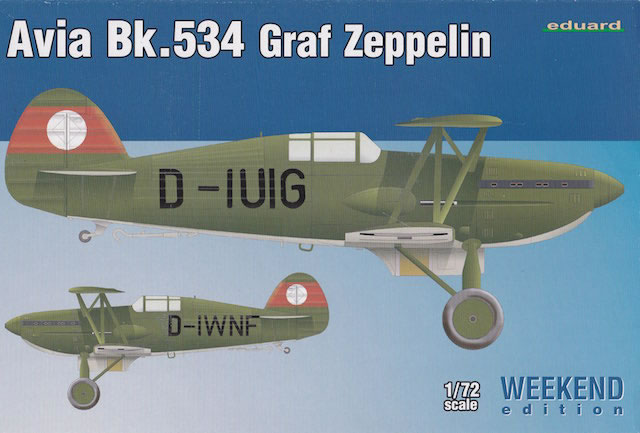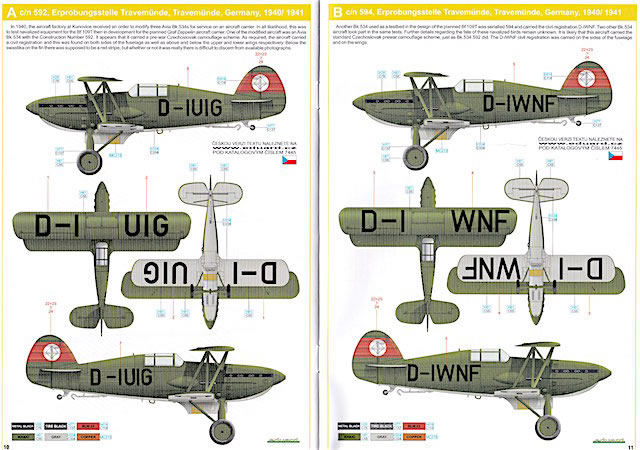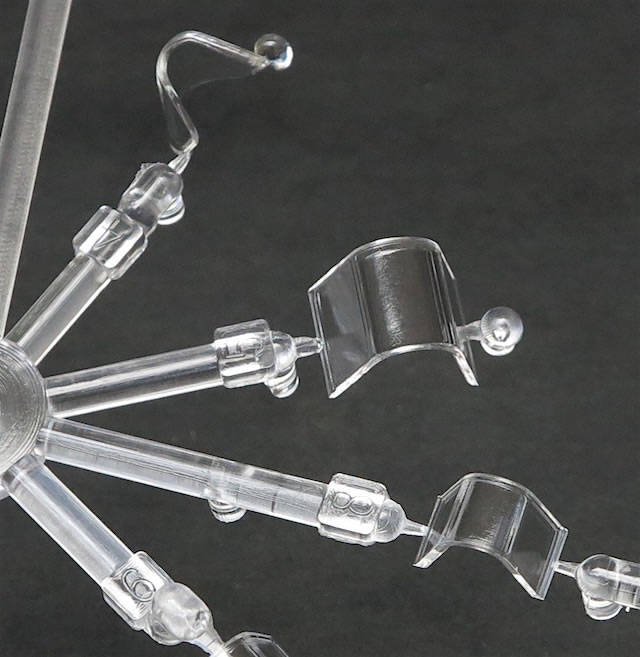|
Avia Bk.534 Graf Zeppelin
Weekend Edition

Eduard, 1/72 scale
S
u m m a r y |
| Catalogue Number and Price: |
Eduard Kit No. 7445 – Avia B.534 Graf Zeppelin Weekend Edition
US $14.95 plus shipping available online from the Eduard website and specialist hobby retailers worldwide
|
| Scale: |
1/72 |
| Contents and Media: |
Approx.90 grey plastic parts (36 unused); eight clear plastic parts (three unused); one decal sheet with markings for two German Bk.534s; 12 page instruction booklet with full colour painting guide. |
| Review Type: |
FirstLook |
| Advantages: |
Excellent kit; good instructions; interesting marking options. |
| Disadvantages: |
None noted. |
| Conclusion: |
Another fine entry into Eduard’s 1/72 B.534 range. |
Reviewed by Brad Fallen

Eduard's 1/72 scale Fw 190 A-5/A-8 Grunherz Limited Edition Dual Combo
is available online from Squadron.com
Eduard’s 1/48 and 1/72 Avia B-534 kits are the best available of this aircraft in any scale. Reviewing the original 1/48 III.serie and IV.serie kits back in 2007, Brett Green highly recommended both releases and concluded that they featured “some of the most convincing surface detail ever moulded in polystyrene plastic”. Mark Davies was similarly positive about Eduard’s 1/72 B-534 family when this was launched in 2015. Eduard has since released many B-534 kits in each scale – most recently a series of 1/72 Weekend Edition boxings covering I.serie, II.serie and Bk.534 machines. I’ll examine the latter here, before looking at the I. and II.serie kits in the near future.

The Bk.534 was one of the final steps in B-534 evolution, designed to boost the machine gun-only armament of earlier versions with an Oerlikon FFS-20 cannon firing through the propeller hub. However it was a design out of time, and not just because of its biplane obsolescence. Of the approximately 120 Bk.534s produced, less than half were manufactured – and only a handful accepted into service – before Czechoslovakia was absorbed by Nazi Germany in early 1939. The Germans maintained production and used the Bk.534 in a variety of roles, including three as testbeds for Hitler’s proposed (but abandoned) carrier operations. Two of the latter aircraft, the civil-registered D-IUIG and D-IWNF, are the subject of this release from Eduard.
Somewhat oddly – given I’m a keen biplane modeller and have always admired the B-534’s sleek lines – this is the first time I’ve taken a close look at Eduard’s 1/72 kit. As a Weekend Edition this boxing doesn’t have all the bells and whistles of a Profipak release. The compact 30 x 20 cm (12 x 8 in) box is simply but effectively illustrated with profile views of the subject aircraft; inside there are just three grey sprues, one small clear sprue, one decal sheet and a 12-page instruction booklet. These don’t come close to filling the box, but fortunately this kit is very much a case of quality over quantity.
As Mark noted in his 2015 review, the plastic mouldings are very high quality. The fuselage halves are amongst the best one-piece mouldings I have seen, with their depiction of metal panels, taut fabric and minute detail. Of particular note here are the exhaust stubs, machine guns, and scoops and grills. The flying surfaces are also well done, with crisp rib detail that with careful painting and weathering will look convincing.

The Bk.534’s design means that while the upper wing can be provided as a single part, the lower wing must of necessity be split into port and starboard halves. Alignment of these parts will be a make or break part of the build, so I’d recommend taking your time and triple checking that the wings don’t move while the glue is drying.
Most of the small parts are on sprue K, which is common to all of Eduard’s 1/72 B-534 boxings. As a result many are not required for this build – in fact more than a third of the parts in the kit are destined for the spares box. These smaller parts are also well moulded, with narrow sprue gates that should help minimise damage as the parts are removed from their runners. I did notice a little flash on some of these parts, for example the propellers, but this will be easily removed.
Parts specific to this boxing, such as the open-ended spinner and the all-important tail hook, are on sprue L with the Bk.534 fuselage halves. In my view, they have slightly finer detail (and no flash) compared to the parts on sprue K.
You’ll only need three of the eight parts on the generic B-534 canopy sprue. These are very clear and – notwithstanding the Bk.534’s sliding canopy – designed to be posed in the open position only.

I would strongly recommend investing in Eduard’s dedicated masking set when you are building this kit. This will help you avoid frustration not only when you are painting the canopy, but also the wheels and the lower wing and tailplanes, onto which the upper surface colours intruded just enough to complicate painting.
The decal sheet is comparatively large for a 1/72 kit with only two marking options. This is because of the civil registration code that each aircraft carried on its fuselage sides and upper and lower wing surfaces. The decals have been produced in-house by Eduard and look good on the sheet, with well-defined letters and no colour bleeding. There is however a lot of carrier film on the civil codes, that have each been printed as single decals. This is a recipe for silvering; to avoid this I’d recommend carefully trimming away some of the film before applying the decals to a very glossy surface.

The decal sheet includes seat harnesses and instrument dials, as substitutes for the photo-etched equivalents that would be present in a Profipak boxing.
The instruction booklet includes a well illustrated and sensibly arranged sequence for construction, followed by a rigging diagram, four view full colour drawings of the two subjects, and two greyscale profiles for stencil placement. I’ve read build reviews of this kit that highlight the rigging diagram as being less helpful than it might – while also pointing out that there are plenty of online sources for the information you need here. My weapon of choice for rigging would be EZ-Line elastic thread, although I’ve seen excellent results achieved with monofilament line.
Markings
As is now standard (and welcome) practice with Weekend Edition releases, this kit contains markings for two of the three Bk.534s modified for carrier service:
D-IUIG/cn 592, and D-IWNF/cn 594.
According to the instructions both were based at Travemunde in Germany in 1940-41, and identically finished in khaki over grey.
The black, white and red Hakenkreuz insignia on the rudder and vertical fin provides a welcome splash of colour.
This kit is another fine entry into Eduard’s collection of 1/72 B-534 releases. The plastic parts are excellent, and combined with the instructions and decals should allow you to make short work of what looks like a pretty user-friendly biplane kit. Capping off the package are the two interesting if slightly esoteric marking options. I don’t normally build 1/72 single seat aircraft, but I think I will be making an exception here.
Thanks to Eduard for the sample
Review Text Copyright © 2019 by Brad Fallen
Page Created 30 January, 2019
Last updated
30 January, 2019
Back to HyperScale Main Page
Back to Reviews Page Woo! |
